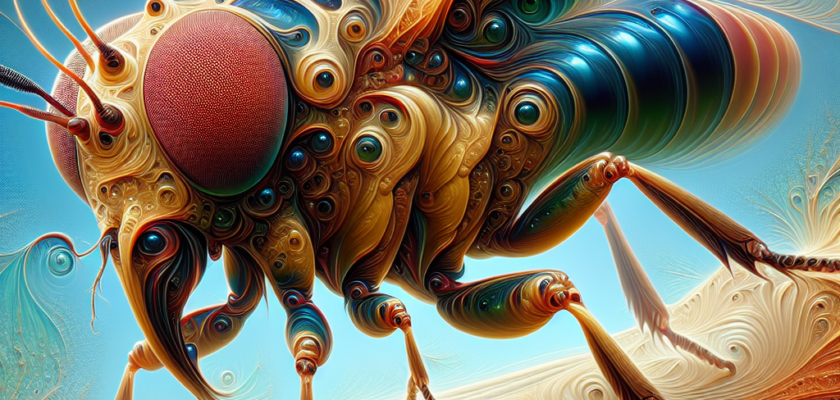Ever wondered who the real life superheroes and supervillains in the bug world are? Well, buckle up buttercup, because we are about to dive into the wild and wacky realm of the world’s most interesting insects! These little critters could beat any Marvel or DC lineup, hands down. Did you know that the Hercules beetle can lift up to 850 times its own weight? That’s like a human hoisting six double-decker buses over their head while casually solving a Rubik’s Cube. And let’s not overlook the Bombardier beetle, that gleefully sprays boiling chemicals from its rear end when threatened, making it the not-so-cuddly skunk of the insect kingdom.
As we wiggle deeper into the rabbit hole – or should I say, ant hill? – of entomological intrigue, we’ll soon explore how these creatures don’t just thrive on super strength and chemical warfare. No siree! They are the masters of disguise with the ability to vanish before your very eyes, like the walking stick insect that moonlights as a twig, giving David Copperfield a run for his money. Hold onto your hats because coming up next, I’ll take you through a parade of six-legged wonders, each with its own party trick that makes it a standout in this insect circus. From the savvy social networking of bees to the Lucha Libre style wrestling matches of Japanese rhinoceros beetles, we’re about to uncover the key takeaways that will make you the life of any (nerdy) party!
Key points I covered in this post
1. The world is home to an estimated 10 million species of insects, showcasing an astonishing variety of shapes, sizes, and unique behaviors. These creatures play vital roles in ecosystems, such as pollinating plants, decomposing waste, and serving as a food source for many other animals.
2. The Orchid Mantis, native to Southeast Asia, is renowned for its striking resemblance to flowers, specifically orchids. This adaptation allows it to blend in with the floral environment to attract prey and evade predators, making it an intriguing example of aggressive mimicry in the insect world.
3. The Bombardier Beetle possesses one of the most impressive defense mechanisms found in insects. When threatened, it ejects a high-temperature chemical spray from its abdomen, which is generated through a violent reaction of hydroquinones and hydrogen peroxide. This has fascinated scientists and illustrates the complexity of chemical defenses.
4. Social structures in insect colonies are highly sophisticated, with the Honeybee being a prime example. These insects exhibit complex communication methods, including the “waggle dance,” which is used to inform other members of the colony about the direction and distance to sources of food or new nesting sites.
5. Bioluminescence is a wondrous trait exhibited by various insects, such as fireflies, which use light produced within their bodies to communicate and attract mates. This phenomenon involves an enzymatic reaction that results in the emission of a soft glow, a subject of study for its potential applications in medicine, agriculture, and environmental monitoring.
Which Insects Rank Among the Most Fascinating in the World?
In assessing the world’s most fascinating insects, several species stand out due to their unique characteristics and behaviors. The **Mantis shrimp**, although not strictly an insect but often included in such discussions, is renowned for its powerful punch and hyperspectral vision. The **Atlas moth**, with its colossal wingspan and snake mimicry, dazzles onlookers. Meanwhile, the bioluminescent glow of the **Firefly** creates enchanting light shows at dusk. Equally interesting is the **Bombardier beetle**, which concocts a boiling chemical spray to deter predators. These are just a few examples that lend credence to the diversity and intrigue of insects around the globe.
The Marvelous Mechanisms of the Bombardier Beetle
The Bombardier Beetle is a master of chemical warfare. When threatened, it ejects a hot chemical spray from its abdomen with a popping sound, deterring even the most persistent of predators. This astonishing defense mechanism involves a reaction between two substances stored separately in its body, which mix in a specially adapted chamber to produce the noxious spray. The beetle’s precision in timing and aim makes it a marvel of the insect world.
The Architectural Genius of Termite Mounds
Termites are known for their ability to build towering mounds that sustain complex societies. These structures are feats of engineering, with intricate systems for ventilation and temperature regulation. The mounds are constructed from a mix of soil, saliva, and feces, creating strong and temperature-efficient habitats. The societal structure within the mounds is just as complex, with clear divisions of labor amongst worker, soldier, and reproductive castes.
Mimicry and Camouflage: The Atlas Moth
The Atlas moth, one of the largest moths in the world, displays fascinating techniques of mimicry and camouflage. Its wingtips harbor patterns that strikingly resemble the head of a snake, deterring predators from attacking. Additionally, its coloring allows it to blend seamlessly into the environment when it rests with wings spread, providing an effective method of concealment from potential threats.
The Firefly’s Luminous Love Signals
Fireflies create a mesmerizing spectacle with their bioluminescent abdomens. These beacons of light are not just for human admiration; they serve a critical function in the firefly’s life cycle, acting as mating signals. Each firefly species has a distinct pattern of flashes that attract suitable mates, creating a complex language of light in the insect world.
The Extraordinary Navigation Skills of Monarch Butterflies
Monarch butterflies undertake one of the most remarkable migrations of any insect. They travel thousands of miles over multiple generations, from North America to Mexico and back. This epic journey relies on an internal navigational system that considers the position of the sun and a biological clock located in their antennae, a process that continues to bewilder and fascinate scientists.
The Unusual Diet of the Antlion Larva
Antlion larvae have a particularly unusual and deadly method of feeding. They construct conical pits in sandy soil and lie hidden at the bottom, waiting for unsuspecting ants or other insects to tumble in. The larvae then use their formidable mandibles to seize the prey, demonstrating a fascinating adaptation for survival.
How Can You Attract and Observe Interesting Insects in Your Own Backyard?
- Plant native flowering plants to attract a variety of pollinators, including unique insects.
- Install a light source in your garden to observe nocturnal insects such as moths and fireflies.
- Create a small water feature or damp area to attract insects like damselflies and dragonflies.
- Leave a part of your garden wild with logs and leaf litter to encourage beetle species to inhabit it.
- Consider building an insect hotel to offer refuge for a variety of species, including solitary bees and lacewings.
What are some examples of insects considered most interesting?
Among the most fascinating insects in the world are the Madagascar hissing cockroach, known for its unique sound, the giant weta of New Zealand, holding the record as one of the heaviest insects, the beautiful, iridescent Morpho butterflies, the bioluminescent fireflies, and the incredibly industrious leafcutter ants that cultivate fungi.
How are these insects beneficial to their ecosystems?
Interesting insects like bees are crucial for pollination, which supports plant reproduction. Leafcutter ants contribute to the soil aeration and composting, whereas dung beetles recycle waste. Predatory insects such as praying mantises help control pest populations, maintaining ecological balance within their habitats.
How do insects adapt to their environment to become interesting?
Insects exhibit an array of adaptations that make them remarkable, such as the camouflage abilities of stick insects or the metamorphosis process of butterflies and moths. Bombardier beetles are capable of expelling hot chemical sprays as a defence mechanism, and some species, like the Arctic woolly bear moth caterpillar, have adapted to survive in extreme temperatures.
Why are some insects considered pests, while others are seen as fascinating?
Perception of insects as pests or fascinating creatures often depends on their impact on human activities. Insects like mosquitoes are considered pests due to their role in disease transmission, while others, such as the jewel beetles with their metallic sheen, are admired for their beauty or intriguing behavior, leaving a positive impression that sparks interest rather than inconvenience.
Can observing interesting insects contribute to scientific research or education?
Observing interesting insects can significantly contribute to scientific and educational fields. Studying their diverse behaviors, complex life cycles, and interactions within ecosystems provides insights into evolution, biodiversity, and environmental health. In education, they can serve as engaging subjects for teaching biological concepts and the importance of conservation.
Final Thoughts
Insects are often overlooked despite their vast diversity and the fascinating facets of their existence. These tiny creatures hold records, perform incredible feats of strength and survival, and continue to intrigue and inspire scientists and nature enthusiasts alike. The world’s most interesting insects are not only a testament to the incredible adaptability and variety of life on our planet but are also integral to the health of ecosystems globally. We must continue to study and protect these amazing species to ensure they thrive for generations to witness and marvel at.
Our appreciation of these captivating insects can motivate greater efforts in conservation and biodiversity preservation. By recognizing their roles in our world, not just as curiosities but as essential contributors to the ecological balance, we can foster a more harmonious coexistence with the natural world. The endless discoveries awaiting in the tiny realms they inhabit are reminders of the vastness of wonders shadowed beneath our feet and fluttering unnoticed all around us.

